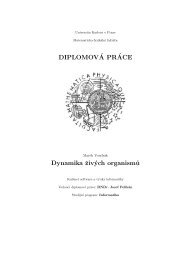Bachelor Thesis - Computer Graphics Group
Bachelor Thesis - Computer Graphics Group
Bachelor Thesis - Computer Graphics Group
You also want an ePaper? Increase the reach of your titles
YUMPU automatically turns print PDFs into web optimized ePapers that Google loves.
vector of fixed length, called the key point count. The algorithm, described<br />
in [2], breaks the gesture down into a sequence of characteristic points that<br />
define significant changes in the shape of the gesture. It works as follows:<br />
• iterate through the list of points in the input sequence. Skip the first<br />
and the last point<br />
• remove the point from the result, if:<br />
– the angle between the consequent segments is close to 180 ◦<br />
– the distance from the last point kept is less than a given threshold<br />
The remaining points now define the shape of the gesture. However, the number<br />
of points can still be different from the requested amount. The polyline<br />
has to be interpolated to achieve the given key point count, by splitting the<br />
longest segments and joining the shortest ones. An overview of the algorithm<br />
can be seen in figure 2.3.<br />
Key point identification Interpolation<br />
Figure 2.3: Overview of the preprocessing algorithm<br />
Now when the input is normalized, we can proceed with the classification. Two<br />
different gesture classifiers will be used. They both use the same preprocessing<br />
algorithm. However, the input representation is different.<br />
2.2 Neural network<br />
A standard artificial neural network [4] with following properties will be used:<br />
• three layers - input, hidden, output<br />
• log-sigmoid activation function<br />
• back-propagation training<br />
• variable learning rate with momentum<br />
13
















